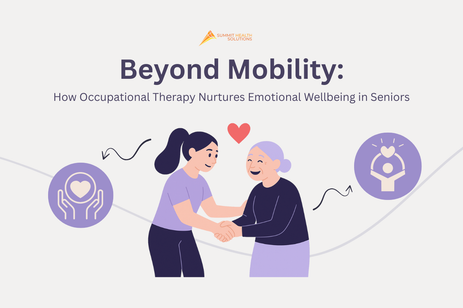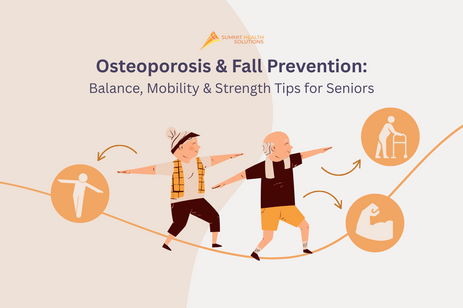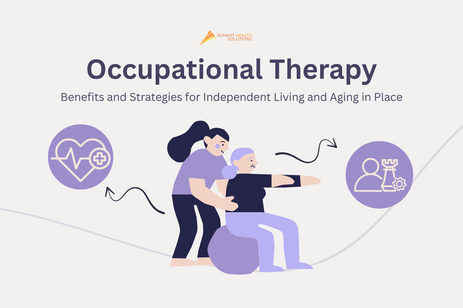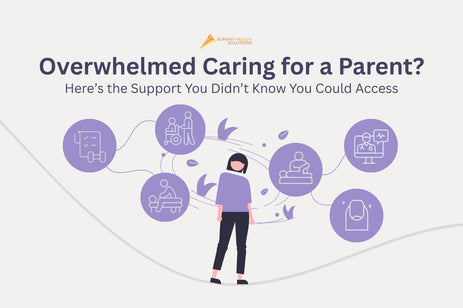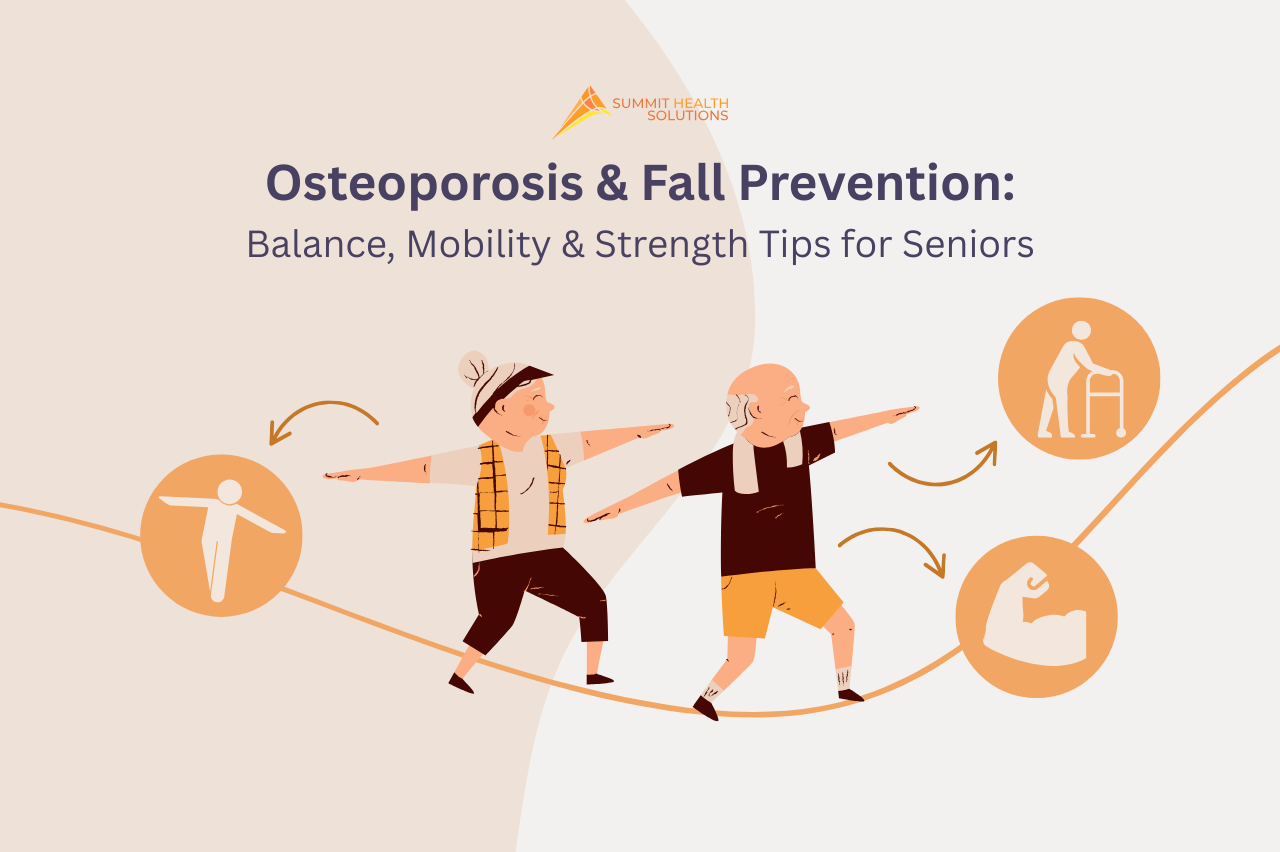
Falls and osteoporosis often go hand in hand in older adults. Fragile bones make even minor slips dangerous, while weaker muscles and balance issues make those slips more likely. Managing both conditions together is crucial for maintaining independence, safety, and confidence.
At Summit Health Solutions, we offer a specialised fall prevention program for seniors that strengthens balance, improves mobility, and builds confidence. This guide explores how osteoporosis increases fall risk, and how strength training, balance exercises, and mobility strategies can make a real difference.
Before we dive in, you might want to check out our related article — How Falls Prevention Helps Families Avoid Crisis Moments at Home — which explores the emotional and practical impact of fall prevention on families.
How Osteoporosis Increases Fall Risk
What is osteoporosis, and why does it matter?
Osteoporosis is a condition that causes bones to become brittle and weak, increasing the likelihood of fractures even from minor falls. According to Healthy Bones Australia, over 1.2 million Australians are living with osteoporosis or low bone density. The risk of a hip or spinal fracture grows exponentially after age 65.
The link between osteoporosis and falls
While osteoporosis affects bone strength, most fractures happen because of falls. Seniors with unsteady gait, mobility issues, or fear of falling often become less active — which unfortunately leads to muscle weakness and poorer balance, further increasing the risk. The Centers for Disease Control and Prevention (CDC) emphasizes that fall prevention is one of the most effective strategies to avoid fractures among older adults with osteoporosis.

Common Risk Factors for Falls in the Elderly
Falls rarely have a single cause — they often arise from a combination of physical, medical, and environmental factors. The major risk factors include:
-
Balance issues or unsteady gait
-
Muscle weakness (especially in legs and core)
-
Vision or hearing problems
-
Medication side effects (dizziness, low blood pressure)
-
Environmental hazards (clutter, rugs, poor lighting)
-
Fear of falling, which leads to inactivity and deconditioning
-
Chronic health conditions like arthritis, diabetes, or neuropathy
Addressing these risk factors through a structured fall prevention program can significantly reduce the likelihood of accidents and maintain independence. (World Health Organization)
Balance, Mobility & Strength Exercises for Seniors
Exercise principles for osteoporosis and fall prevention
The Australian Government’s Department of Health and Aged Care recommends at least 30 minutes of physical activity daily, including balance and strength training. Safe exercises help strengthen bones, improve posture, and boost confidence while reducing fall risk.
Recommended exercises
At Summit Health Solutions, our Fall Prevention Program for Seniors includes a range of balance and strength exercises that are carefully designed to improve mobility, confidence, and bone health. These are some of the core routines we typically use — and you can also try them safely at home or under professional supervision:
-
Heel Raises: Strengthen calves and ankles for stability.
-
Sit-to-Stand: Builds thigh and hip strength crucial for mobility.
-
Single-Leg Balance: Stand on one leg for 10–15 seconds, improving coordination.
-
Mini Squats: Strengthen lower body and core muscles safely.
-
Heel-to-Toe Walk: Improves gait and balance control.
-
Gentle Core Training (modified planks or seated exercises): Enhances trunk stability.
These movements target balance, mobility, and muscle coordination — all key to preventing falls and supporting bone health. For a step-by-step guide, see Johns Hopkins Medicine’s fall prevention exercises.
Mobility Tips for Everyday Confidence
Improving mobility doesn’t just mean walking more — it’s about moving safely, with awareness and control.
-
Walk outdoors regularly: Uneven terrain challenges balance and coordination.
-
Review medications: Ask your GP or pharmacist to check if any may cause dizziness.
-
Update your eyewear: Vision changes are a major risk factor for falls in the elderly.
-
Modify your home: Add grab bars in the bathroom, non-slip mats, and better lighting.
-
Wear proper footwear: Choose supportive, closed-toe shoes with non-slip soles.
According to HealthDirect Australia, small environmental changes can cut home fall risk by over 30%.
Why Summit Health Solutions’ Fall Prevention Program Works
At Summit Health Solutions, our evidence-based fall prevention program for seniors combines clinical assessment, tailored exercises, and home safety education. Here’s what you can expect:
-
Comprehensive falls risk assessment – identifies strength, balance, and mobility deficits.
-
Personalised training plan – includes safe, progressive balance exercises and strength training specific to osteoporosis.
-
Home environment review – recommendations for lighting, flooring, and grab rail installation.
-
Ongoing monitoring – track improvement and prevent relapse in mobility issues.
-
Confidence building – helping clients overcome fear of falling and regain independence.
Our program is built around the research from the World Health Organization, focusing on bone health, balance, and functional mobility.
Take the Falls Risk Assessment Checklist
If you’re unsure about your or a loved one’s fall risk, take a few minutes to complete our Falls Risk Assessment Checklist.
This short, easy self-check will help identify potential hazards and lifestyle factors contributing to your fall risk — from balance issues and unsteady gait to home safety gaps. It’s a quick first step toward building a safer living environment and protecting your bone health.
We encourage families to complete it together — because fall prevention doesn’t just benefit individuals; it protects families from crisis moments at home.
Frequently Asked Questions (FAQs)
Can osteoporosis increase my chances of falling?
Not directly, but osteoporosis often comes with muscle weakness and balance decline, which do increase fall risk.
What type of exercise helps both osteoporosis and fall prevention?
Balance, mobility, and strength training exercises — such as heel raises, squats, and core work — build muscle strength and bone density.
Is it safe for seniors with osteoporosis to do resistance training?
Yes. When guided by a health professional, resistance and balance training are safe and highly effective for fall prevention.
How can I overcome my fear of falling?
Structured, supervised exercise and home safety modifications can rebuild confidence. Joining a program like Summit Health Solutions’ fall prevention program provides reassurance and expert support.
What if I’ve already fallen before?
You’re not alone — falls are common, but with the right interventions (strength, balance, and environmental changes), you can prevent repeat incidents and regain independence.
Preventing falls in the elderly begins with awareness, then action. Strengthening your muscles, improving balance, and making simple home adjustments can drastically reduce your fall risk — and with conditions like osteoporosis, these steps can be life-changing.
Take your first step toward safety and independence today:
✅ Complete our Falls Risk Assessment Checklist to understand your home and physical risk factors.
✅ Explore our Fall Prevention Program for Seniors at Summit Health Solutions, where we combine balance training, mobility support, and osteoporosis management to keep you strong, steady, and confident.


